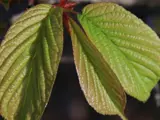 Taiwan cherry
Taiwan cherry
Common name: Taiwan cherry
Botanical name: Prunus campanulata
Management programme: Sustained control - Rule 5a applies
The Taiwan cherry is originally from East Asia, and it was introduced to New Zealand as an ornamental plant in the 1960s.
Tūīs feed on the berries and nectar, but the nectar from these trees only lasts for a couple of weeks. The native nectar supply for tūīs are pohutukawa, flax, kowhai and ngaio, which provide nectar for longer than the Taiwan cherry does. The Taiwan cherry crowds out the native plant species if given the chance and this means the tūī are left with a much shorter time frame and food supply.
- Seems to be able to grow anywhere! Can tolerate all types of climates and rainfall. Forms dense stands that are long-lived.
- Crowds out neighbouring plants and shrubs and dominates a habitat. Restricts the growth of new seedlings and creates a monoculture.
- Seeds are long lived and widely dispersed by birds.
Where is it found?
- Likes the understorey of native forests, shrublands, light wells in forests, roadsides (especially under power lines), gardens and reserves.
- Can spread vegetatively, through garden waste and movement of soil.
- Found throughout the Bay of Plenty.
What does it look like?
- Flowers are red/pink and bell shaped and appear from July to September. The bell shaped flowers distinguish this species from other naturalised Prunus species in New Zealand.
- Fruit is red in colour and glossy. Quite small, about 10mm in diameter.
- Leaves have serrated edges, are bright green when they appear in spring then turn dark green by summer.
What are the rules?
Sustained control
Sustained Control pests are well established in the region and preventing the spread is no longer a realistic objective. Management focuses on reducing general impacts of the pest. Landowners/occupiers are responsible for the control of these pest species on their land. Council may enforce control.
Under rule 5a of the RPMP landowners/occupiers must destroy this pest if required by a written direction from an authorised person unless a property specific pest management agreement has been agreed and signed between the occupier and the Council.
Criteria to meet Rule 5A include when the species is being actively managed by council, other agency and or community group, on an adjacent property. See the Regional Pest Management Plan 2020-2030 rules for Sustained control pests for more information.
How do you get rid of it?
- Hand pull seedlings year round.
- Drill and fill with herbicide year round.
- Cut the trunk and stump treat straight away with herbicide, year round.
Can leave plants in situ to rot down. For larger trees, cut up the branches and trunks and either dry out for firewood or mulch.
On-going control will be required by hand pulling new seedlings that will grow from the seed bank. Keep persevering with the control and when the infestation has reduced and there is no regrowth, plant a dense cover of native shrubs or trees to shade out the remaining seed bank.
CAUTION: When using any herbicide or pesticide, PLEASE READ THE LABEL THOROUGHLY to ensure that all instructions and directions for the purchase, use and storage of the product, are followed and adhered to.
Read more on pest control advice, information and regulations
Images






